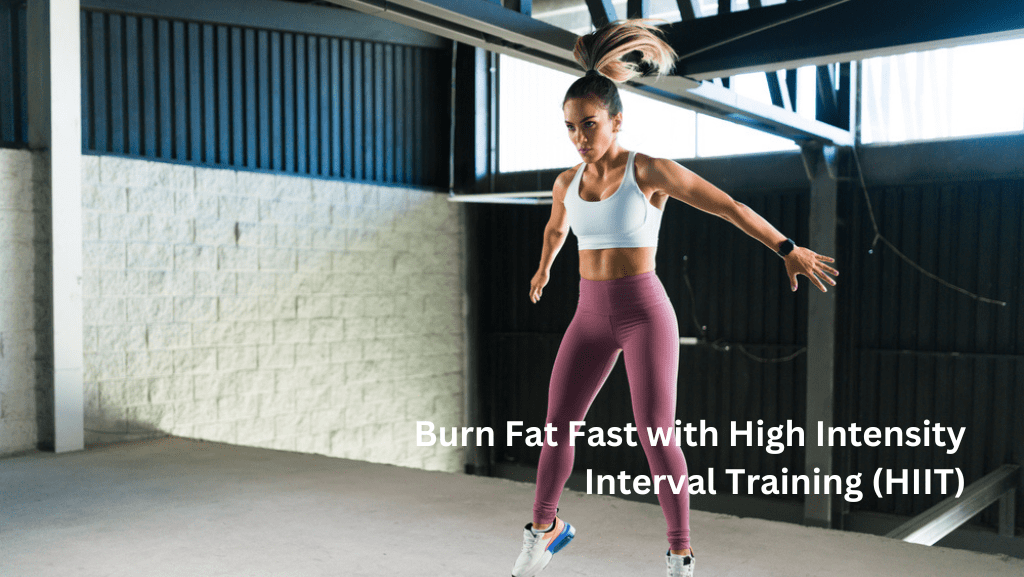Burn Fat Fast with High Intensity Interval Training (HIIT)

Welcome to our article on High Intensity Interval Training (HIIT) – a powerful workout technique that can help you achieve rapid fat loss and boost your fitness levels. If you’re looking to burn fat fast and get results, HIIT is the way to go. In this article, we will explore the benefits, science, and various aspects of HIIT that make it an effective fat-burning workout.
What is High Intensity Interval Training?
High Intensity Interval Training (HIIT) is a popular exercise method that involves alternating between short bursts of intense activity and brief recovery periods. Unlike traditional steady-state cardio workouts, HIIT pushes your body to its limits, maximizing calorie burn and boosting your metabolism.
During a HIIT session, you perform exercises at a high intensity for a set period, typically between 20 to 60 seconds, followed by a short rest interval. This pattern is repeated for several rounds, creating a challenging and efficient workout.
The key to HIIT’s effectiveness lies in the concept of “excess post-exercise oxygen consumption” (EPOC). This refers to the additional calories your body continues to burn after your workout as it works to repair and recover. HIIT stimulates EPOC to a greater extent than steady-state cardio, leading to increased calorie expenditure even while at rest.
Moreover, HIIT workouts can be customized to suit your fitness level and preferences. Whether you prefer running, biking, or bodyweight exercises, HIIT can be adapted to various forms of cardiovascular and muscular training.
The Benefits of High Intensity Interval Training
- Rapid Calorie Burn: HIIT can help you burn more calories in a shorter amount of time, making it an efficient choice for those with busy schedules.
- Increased Metabolic Rate: HIIT workouts can boost your metabolism and keep it elevated for hours after your session, leading to continued fat burning.
- Improved Cardiovascular Fitness: Regular HIIT exercises can enhance your cardiovascular endurance and improve heart health.
- Muscle Tone and Strength: HIIT workouts challenge multiple muscle groups, helping you build strength and improve overall muscle tone.
- Flexibility and Adaptability: HIIT exercises can be modified to suit different fitness levels and specific goals, allowing for individual customization.
The Science behind High Intensity Interval Training
High Intensity Interval Training (HIIT) is not just a trendy workout; it’s backed by scientific principles that make it an effective fat-burning regimen. This intense form of exercise involves alternating between short, high-intensity bursts of activity and brief periods of rest or active recovery.
So, what happens to your body during HIIT? Let’s explore the science behind it.
- Metabolism Boost: HIIT stimulates your body’s metabolism, causing it to work harder and burn more calories during and after exercise. This is known as the afterburn effect or excess post-exercise oxygen consumption (EPOC).
- Increased Fat Oxidation: HIIT activates specific enzymes that enhance fat oxidation, allowing your body to use stored fat as a source of energy.
- Cardiovascular Benefits: HIIT improves cardiovascular fitness by challenging your heart and lungs, increasing their capacity to deliver oxygen to your muscles efficiently.
- Time Efficiency: HIIT workouts are typically shorter than traditional cardio sessions while providing similar or even greater benefits in terms of calorie burning and fitness gains.
By engaging in HIIT, you engage multiple muscle groups, which helps to burn more calories. Additionally, the high-intensity nature of the workout puts your body under stress and triggers adaptations that lead to improved aerobic and anaerobic fitness, making you stronger and fitter over time.
If you want to take your fat-burning efforts to the next level, High Intensity Interval Training (HIIT) is the way to go. Its scientific foundation, combined with its efficiency and effectiveness, makes it a preferred choice for individuals looking to maximize their calorie burn and achieve rapid results.
Benefits of High Intensity Interval Training

High Intensity Interval Training (HIIT) offers numerous advantages that make it a popular choice among fitness enthusiasts. Whether you’re a beginner or an experienced athlete, HIIT can help you achieve your fitness goals efficiently and effectively.
- Time Efficiency: HIIT workouts are known for their time-saving benefits. With shorter workout durations compared to traditional cardio exercises, you can get more done in less time.
- Increased Calorie Burn: HIIT workouts are designed to push your body to its limits. The intense bursts of activity followed by short recovery periods increase your heart rate and stimulate calorie burning, helping you shed excess fat.
- Cardiovascular Fitness: HIIT workouts improve cardiovascular endurance by challenging your heart and lungs. Regular participation in HIIT can enhance your overall cardiovascular health.
- Muscle Gain: HIIT exercises engage multiple muscle groups, promoting muscle growth and strength development. This makes HIIT a versatile option for those looking to build lean muscle mass.
- Metabolic Boost: HIIT workouts have been shown to elevate your metabolism even after you finish exercising, leading to continued calorie burn throughout the day.
Whether you’re aiming to lose weight, improve your cardiovascular fitness, or build strength, High Intensity Interval Training (HIIT) can provide you with a challenging and effective workout that delivers results.
Designing an Effective HIIT Workout
High Intensity Interval Training (HIIT) is a powerful way to torch calories and enhance your fitness levels. To design a HIIT workout that aligns with your fitness goals, there are several key factors to consider.
1. Exercise Selection
Choose exercises that engage multiple muscle groups and get your heart rate soaring. Examples include burpees, mountain climbers, jumping lunges, and kettlebell swings. Incorporating a mix of cardiovascular and strength-based exercises will yield comprehensive results.
2. Interval Structure
The interval structure is crucial for optimizing the effectiveness of your HIIT workout. Aim for a ratio of work to rest intervals, such as 30 seconds of intense exercise followed by 10 seconds of active recovery. Experiment with different interval lengths to find what works best for your fitness level and goals.
3. Intensity and Progression
Push yourself to work at a high intensity during each interval, challenging your limits while maintaining proper form. As you progress, gradually increase the intensity by reducing rest periods, adding weights, or increasing the speed or resistance level. Consistently challenging yourself will ensure continued improvement.
4. Duration and Frequency
The duration of your HIIT workout will depend on your fitness level and available time. Start with a 15-20 minute session and gradually increase the duration as you build stamina. Aim to incorporate HIIT workouts into your routine 2-3 times per week for optimal results.
5. Warm-up and Cool-down
Before diving into your HIIT workout, make sure to include a dynamic warm-up to prepare your body for the intense exercise. This can involve light jogging, dynamic stretches, and mobility exercises. Similarly, finish your workout with a cool-down to lower your heart rate gradually and stretch your muscles.
By considering these elements and tailoring your HIIT workout accordingly, you can create an effective training regimen that maximizes calorie burn, improves cardiovascular fitness, and helps you achieve your fitness goals faster.
HIIT for Fat Loss: Tips and Tricks
If you’re looking to maximize fat loss through High Intensity Interval Training (HIIT), incorporating these tips and tricks into your workout routine can help you achieve rapid results. From nutrition recommendations to tracking your progress, optimizing your HIIT workouts is key to reaching your fat loss goals.
Fuel Your Workouts
- Prioritize nutrient-dense foods that provide sustained energy for your HIIT workouts.
- Include a balance of carbohydrates and protein to support muscle recovery and growth.
- Stay hydrated by drinking enough water throughout the day and before, during, and after your workouts.
Variety is Key
- Keep your HIIT workouts exciting and challenging by incorporating different exercises and intervals.
- Try adding bodyweight exercises, kettlebell swings, or rowing intervals to your routine.
- Experiment with different work-to-rest ratios to keep your body continuously adapting.
Track Your Progress
- Keep a workout journal or use a fitness app to record your HIIT workouts and monitor your progress.
- Track metrics such as workout duration, intensity level, and any modifications or improvements over time.
- Regularly reassess your goals and adjust your workouts accordingly to continue challenging yourself.
Recovery and Rest
- Listen to your body and prioritize rest and recovery days to prevent overtraining.
- Include active recovery activities such as yoga or light cardio on rest days.
- Ensure you’re getting enough sleep to support muscle repair and optimize fat loss.
By following these tips and tricks, you can make the most out of your High Intensity Interval Training (HIIT) workouts and accelerate your fat loss journey.
HIIT Variations for Optimal Results
High Intensity Interval Training (HIIT) is known for its effectiveness in burning fat and improving fitness. To keep your workouts fresh and challenging, it’s important to explore different variations of HIIT. By incorporating HIIT into various types of exercises, such as running, cycling, or bodyweight training, you can optimize your results and prevent boredom.
Here are some HIIT variations to consider:
- Tabata Intervals: Tabata training involves performing ultra-high intensity exercises for 20 seconds, followed by 10 seconds of rest, repeated for 8 rounds. This intense form of HIIT is great for boosting cardiovascular fitness and increasing anaerobic capacity.
- Pyramid Intervals: Pyramid intervals involve gradually increasing and then decreasing the intensity and duration of your intervals. For example, you could start with 20 seconds of high-intensity exercise, followed by 10 seconds of rest, then increase the intervals to 30 seconds, 40 seconds, and so on, before gradually decreasing back down.
- Cardio-Strength Circuit: Combine cardiovascular exercises with strength training for a full-body workout. Alternate between high-intensity cardio exercises, such as burpees or jump squats, and strength exercises like push-ups or lunges. This variation helps build strength while also improving cardiovascular endurance.
- HIIT with weights: Incorporate weights or resistance bands into your HIIT routine to add an extra challenge. Perform exercises like squat presses, kettlebell swings, or renegade rows to increase the intensity and engage more muscle groups.
- HIIT on the Stairs: Instead of using a traditional cardio machine, try doing HIIT on a set of stairs. Sprint up the stairs, focusing on high-intensity bursts, then recover by walking or jogging back down. This variation adds a plyometric element and targets your lower body muscles.
Remember to adjust the intensity and duration of your intervals based on your fitness level and goals. It’s important to push yourself during the high-intensity intervals while allowing for adequate recovery during the rest periods.
By incorporating these HIIT variations into your fitness routine, you can continue to challenge your body and achieve optimal results in fat burning and overall fitness.
Conclusion
High Intensity Interval Training (HIIT) offers a proven and effective method to burn fat and enhance fitness. Through alternating bursts of intense activity and short recovery periods, HIIT maximizes calorie burn and stimulates the metabolism long after your workout is over.
Consistency is key when it comes to achieving optimal results with HIIT. By incorporating regular HIIT workouts into your fitness routine, you can expect to see significant improvements in cardiovascular endurance, increased calorie burn, and accelerated fat loss.
However, it’s important to approach HIIT with caution and prioritize proper form to minimize the risk of injury. Starting slowly and gradually increasing the intensity, while listening to your body’s signals, will ensure a safe and effective workout experience.
In conclusion, if you’re looking for a time-efficient and highly effective way to burn fat and improve your fitness level, High Intensity Interval Training (HIIT) is the answer. By incorporating HIIT into your exercise routine and maintaining consistency, you can achieve your fitness goals and experience the benefits of this dynamic and challenging workout style.
FAQ
What is High Intensity Interval Training (HIIT)?
High Intensity Interval Training (HIIT) is a form of exercise that involves alternating between short bursts of intense activity and brief recovery periods. This method is designed to maximize calorie burn, boost metabolism, and improve cardiovascular fitness.
How does High Intensity Interval Training (HIIT) differ from other forms of exercise?
Unlike traditional steady-state cardio workouts, HIIT involves performing exercises at a high intensity for a short duration, typically followed by a period of active recovery. This alternating pattern helps to increase the heart rate and encourage the body to burn more calories even after the workout has ended.
What are the benefits of High Intensity Interval Training (HIIT)?
HIIT offers several benefits, including improved cardiovascular fitness, increased calorie burn, enhanced metabolism, and time efficiency. It can also help preserve muscle mass and promote fat loss when combined with a balanced diet.
How do I design an effective HIIT workout?
To create an effective HIIT workout, you can choose exercises that target different muscle groups and vary the intensity and duration of each exercise interval. It’s crucial to maintain proper form and gradually increase the intensity as your fitness level improves.
Are there any tips and tricks for maximizing fat loss with HIIT?
Some tips for maximizing fat loss with HIIT include staying consistent with your workouts, fueling your body with nutritious food, tracking your progress, and giving your body adequate rest and recovery time.
Can HIIT be incorporated into different types of exercises?
Absolutely! HIIT can be incorporated into various exercises, such as running, cycling, bodyweight training, and even strength training. The key is to focus on maintaining high intensity during the work intervals and properly recovering during the rest intervals.
Is it necessary to consult a fitness professional before starting HIIT?
While not mandatory, consulting a fitness professional can be beneficial, especially if you are new to exercise or have any pre-existing medical conditions. They can guide you on proper form, intensity levels, and help design a HIIT workout plan that suits your individual needs.



